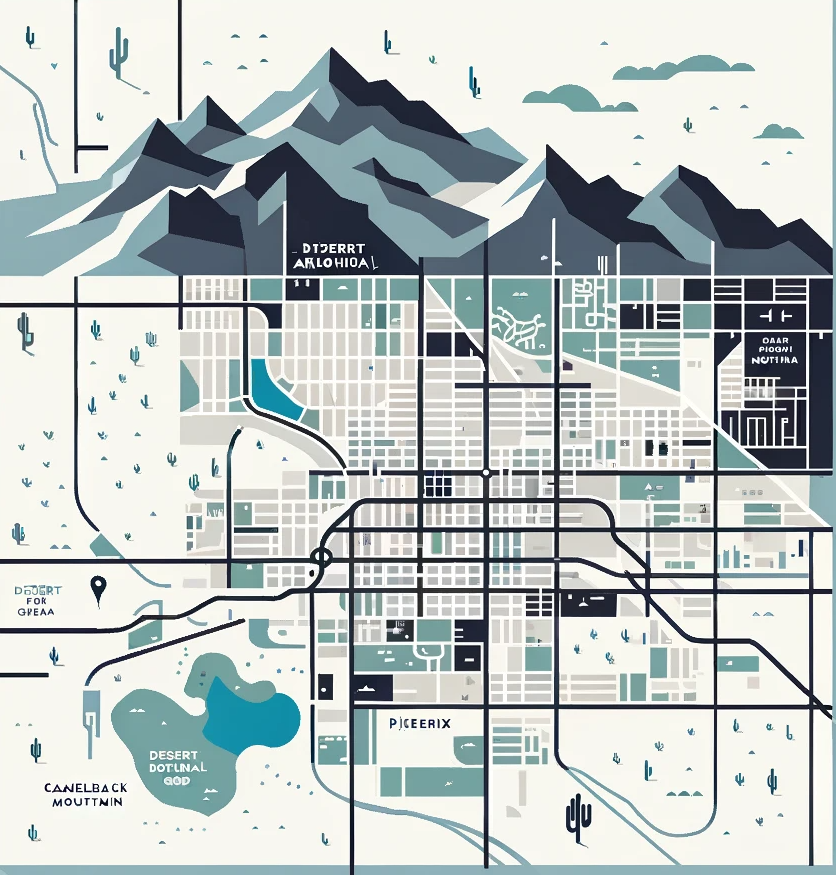
Phoenix Transportation Overview
Public Transit
Valley Metro is the go-to for public transit drivers, desert community trips in Phoenix. It offers bus and light rail services across central Phoenix and its neighboring communities, with dedicated drivers for each line. Riders have various fare options, making it flexible. The system, a means for trips to work, covers a vast area, ensuring most places in central Phoenix are accessible.
The convenience of multiple fare choices for trips and work means caters to everyone’s needs. Whether you’re a daily commuter to work or an occasional rider, there’s a means of trips for you.
Rail Systems
The light rail connects key work areas like Phoenix, Mesa, and Tempe. Commuters can use park-and-ride facilities. This makes daily travel easier.
Future expansions promise an even broader network. They aim to connect more neighborhoods and increase accessibility.
Road Networks
Phoenix’s road networks are crucial for drivers. Interstate 10 and Interstate 17 are major highways cutting through the city. The Arizona Department of Transportation (ADOT) keeps travelers updated on conditions.
During rush hours, carpool lanes offer quicker commutes for shared rides.
Bike Trails
Cyclists enjoy over 200 miles of bike lanes in Phoenix. Canal paths provide scenic routes away from busy roads.
Plans to expand these trails will make biking safer and more enjoyable across the city.
- Dedicated bike lanes ensure cyclist safety.
- Scenic canal paths offer peaceful rides away from traffic.
Understanding Phoenix’s Public Buses
Routes
Phoenix offers a variety of bus routes to navigate the city efficiently. The Valley Metro website provides handy trip planner tools. These tools help you find the best route for your journey. There are also designated scenic routes. They’re perfect for leisurely drives through Phoenix’s beautiful landscapes.
The city is bicycle-friendly, with marked streets throughout. This makes it easy to combine cycling and bus travel for your commutes.
Schedules
The light rail in Phoenix operates from early morning until late at night, offering a reliable option for travelers. Bus schedules, however, vary by route. On weekends, service is reduced across most routes.
For those who need up-to-the-minute information, real-time updates are available through various transit apps. These apps make it easier to plan your day without worrying about missing a bus or light rail.
Fares
Phoenix public transit offers several fare options to suit different needs:
- Single ride tickets if you’re just hopping around town.
- Day passes for unlimited rides on buses and light rail.
- Monthly passes that provide great value for regular commuters.
There are reduced fares available too:
- Students,
- Seniors,
- Disabled riders all benefit from lower prices.
An all-day pass allows unlimited rides on both buses and light rail systems throughout the day.
Navigating the Rail System
Light Rail
Stations
Phoenix’s light rail stations make getting around Phoenix easy and accessible. Each station is equipped with ticket vending machines, simplifying the purchase process for riders. For those driving to a station, park-and-ride locations offer free parking. This feature bridges the gap between car travel and public transit seamlessly. Furthermore, every station boasts accessibility features ensuring all passengers can navigate the system with ease.
Tickets
The Valley Metro app introduces convenience by offering mobile ticketing options. It’s a swift way to manage your travel without physical tickets. However, paper tickets remain available at stations or onboard buses for those who prefer them or lack access to a smartphone. Frequent riders benefit from multi-use cards, streamlining their regular commutes.
Commuter Trains
Phoenix currently lacks commuter train services, focusing instead on its robust light rail and bus systems discussed previously including “Understanding Phoenix’s Public Buses”. While this might seem like a gap in the city’s public transit offerings, it’s important to note that discussions are ongoing about potential future commuter rail connections. These talks hint at an exciting possibility of expanded regional connectivity in the future.
Nearby cities are exploring regional rail options that could eventually link to Phoenix, promising enhanced intercity travel prospects for residents and visitors alike. Such developments would significantly broaden transportation choices within this sprawling metropolitan area.
Alternative Transportation Options
Ridesharing
Uber and Lyft have become staples in Phoenix’s transportation scene. They’re everywhere. You can quickly get a ride, no matter where you are in the city. Valley Metro also offers carpool matching services. This is great for daily commutes or attending events with others who live nearby.
High traffic areas have special spots for pickups and drop-offs. This makes ridesharing even more convenient.
Biking
Phoenix’s streets are laid out in a grid. This makes it easy to navigate by bike. Downtown areas offer bike sharing programs, so you don’t even need your own bike to explore.
The city hosts annual biking events too. These promote a strong biking culture among residents and visitors alike.
Walking Paths
Downtown Phoenix and the area around ASU campus are great for walking. These pedestrian-friendly zones encourage exploring on foot. There are signposted walking tours too. They showcase historical and cultural sites throughout the city.
Urban trails link parks to community centers, creating long stretches of scenic paths perfect for an afternoon stroll or morning jog.
Tips for Getting Around Without a Car
Planning Routes
Google Maps is your friend when figuring out how to get around Phoenix. It offers detailed routes whether you’re driving, taking public transit, walking, or biking.
Valley Metro’s online tools are also invaluable. They help you find the most efficient public transit routes. Always consider the time of day and traffic patterns while planning your route. Morning and evening rush hours can significantly affect travel times.
Using Transit Apps
The Valley Metro app is a must-have on your smartphone. It provides real-time tracking of buses and light rail services in Phoenix.
Third-party apps like Moovit go a step further by integrating public transit options with walking directions to offer comprehensive navigation solutions. For those considering ride-sharing options, apps typically display estimated fares and wait times, making it easier to plan both your budget and schedule.
Safety Tips
Safety should always be at the forefront of your mind when getting around without a car. Be extra cautious if you’re using headphones or traveling at night.
Always use designated crosswalks and obey pedestrian signals when walking or biking in Phoenix. If you see something suspicious or notice an unattended package at a transit station, don’t hesitate to report it immediately for everyone’s safety.
The Convenience of Phoenix’s Road System
Major Highways
Phoenix boasts an extensive road system that facilitates easy navigation. I-10 and I-17 are the city’s lifelines. I-10 cuts across Phoenix from east to west, while I-17 runs north-south right through the city center. These highways make getting around straightforward.
Loop 101 and Loop 202 encircle the city outskirts, offering alternative routes. However, rush hours bring heavy traffic on these roads. It’s wise to plan for delays or seek different travel times.
Traffic Patterns
Understanding Phoenix’s traffic patterns is key to a smooth journey. Weekday mornings (7-9 AM) and evenings (4-6 PM) see the heaviest traffic flows. Avoiding these peak times can save you from long waits in bumper-to-bumper traffic.
Weekends offer lighter traffic conditions overall but beware of congestion near malls or event venues. Staying updated with real-time traffic information helps dodge congested areas efficiently.
Exploring Phoenix’s Trails and Paths
Urban Trails
Phoenix offers unique urban trails that blend the city’s natural beauty with its bustling life. The Central Arizona Project (CAP) Canal Trail is a prime example. It provides an urban hiking and biking experience along scenic waterways. This trail is perfect for those who want to explore central Phoenix without straying too far from the heart of the city.
Another gem is the Rio Salado Pathway. It connects several downtown points of interest, making it ideal for tourists and locals alike. For those seeking a more leisurely stroll, Phoenix’s greenbelts offer shaded walks through lush landscapes.
Mountain Biking
For mountain biking enthusiasts, South Mountain Park boasts over 50 miles of trails suitable for all skill levels. It’s a haven where you can challenge yourself amidst breathtaking views.
McDowell Mountain Regional Park also caters to bikers with varied trails that accommodate beginners to advanced riders. Remember, trail etiquette is crucial here; sharing paths with hikers and equestrians ensures everyone enjoys their time safely.
Hiking Trails
Camelback Mountain stands out as a popular spot among hikers in Phoenix. Its challenging hikes reward adventurers with stunning city views at every turn.
Piestewa Peak offers diverse trails within the Phoenix Mountains Preserve, catering to different fitness levels. Most importantly, many trails feature rest areas equipped with amenities like restrooms and water fountains – ensuring your exploration around Phoenix remains comfortable throughout.
Maximizing the Public Transit Experience
Discount Programs
Public transit in Phoenix offers various discount programs. These make commuting affordable for many. Youth, senior citizens, and individuals with disabilities can benefit from reduced fare programs. This initiative supports inclusive travel.
College students have access to the U-Pass program. It allows unlimited rides, making campus commutes easier. Employers can also join discount programs to offer transit benefits to employees. Such initiatives encourage public transport use over personal vehicles.
Accessibility Features
Phoenix’s commitment to inclusivity is evident in its public transit system’s accessibility features. All buses and trains are equipped with wheelchair ramps or lifts, ensuring that everyone can navigate the city effortlessly.
Stations feature tactile paving surfaces to assist visually impaired passengers. Moreover, service animals are welcome aboard all forms of public transportation in Phoenix. These measures ensure a comfortable experience for all passengers.
Transit Centers
Central Station stands as a key hub in Phoenix’s public transit network. It connects buses and light rail, facilitating seamless travel across the city and beyond.
Many transit centers boast amenities like waiting areas, restrooms, and bike racks — enhancing commuter comfort significantly. Park-and-Ride lots around suburban areas simplify accessing public transportation for those living farther from central locations. These centers not only improve connectivity but also support sustainable commuting practices by encouraging the use of shared transport options over personal vehicles.
Frequently Asked Questions
How do I navigate Phoenix using public buses?
Hop on a bus and explore! Phoenix’s bus system is extensive, covering major areas efficiently. Check schedules online or at stops to plan your journey.
Can I get around Phoenix without a car?
Absolutely! Between buses, rail systems, bikes, and walking paths, you’ve got plenty of options to roam the city car-free.
What’s the deal with Phoenix’s rail system?
Think of it as your express lane through the city. The rail connects key points across Phoenix, making it a fast and reliable option for getting around.
Are there alternative transportation options in Phoenix?
Yes! Beyond traditional transit, consider bike-sharing programs or scooters for quick trips. They’re fun ways to see the city from a new perspective.
Any tips for maximizing my public transit experience in Phoenix?
Sure thing! Grab an all-day pass for unlimited rides and download the official transit app to track routes and schedules in real-time. It’s like having a tour guide in your pocket!
Is driving easy in Phoenix due to its road system?
You bet! With wide roads and clear signage, navigating by car is straightforward. Just watch out for peak traffic times to keep things smooth sailing.
Where can I find trails and paths for exploring nature in Phoenix?
Phoenix is dotted with scenic trails perfect for hiking or biking. Look up local parks or preserves—each offers unique views and experiences off the beaten path.



